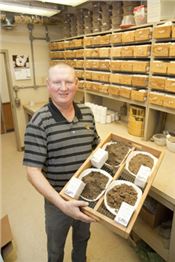Don’t Guess, Soil Test

David Dunn, manager of the soils testing lab at the Fisher
Delta Research Center, discussed the effect of potassium on
yield, grain quality, lodging and stalk strength in rice that he
and Dr. Gene Stevens researched for 19 years.
Photo by John LaRose, Jr.
For A Better Yield, Sow Seed In A Well-Nourished Seedbed
BETTY VALLE GEGG-NAEGER
MidAmerica Farmer Grower
PORTAGEVILLE, MO.
David Dunn, manager of the soils testing lab at the Fisher Delta Research Center located at Portageville, Mo., discussed the effect of potassium on yield, grain quality, lodging and stalk strength in rice.
His talk was a summation of 19 years of research that he and Dr. Gene Stevens conducted on rice at the center. Dunn expounded the many positive aspects of potash and how critical the proper level of potash are for rice production in Missouri.
“The first thing that farmers are in search of is increased yields. Potash or potassium has a distinct effect on grain yields,” he asserted. “If you don’t have enough potash, your yields are going to be limited. We looked at that pretty seriously back when I first started working here in the late ‘90s. One thing that we determined was that potash can put more grain on a rice crop, but that also leads to another problem, and that is lodging. There is too much weight in the head of the rice plant and that causes it to fall over, which slows harvest and impacts the grain quality also. We had looked at some rice varieties from the middle east where they were using potash to decrease lodging and increase stalk strength, so we thought we would give that a try.”
Tests show that potash does have a positive impact on stalk strength and lodging was reduced when the right amount of potash was applied at the right time during the season.
“That led us to question if there is a way we could measure this stalk strength; so here at the Delta Center Dr. Stevens and I developed a system to do that. Basically we hung a basket from the rice stalk and progressively added weights and recorded the weight at which the stalk failed. We determined that there was a pretty good correlation between the amount of potassium in the rice stalk and it’s failing strength. The more potash in the rice, the stronger the stalk was. When we look back at lodging in the field, there was also a very strong correlation between stalk strength and lodging in the fields. We really thought we had something there and it worked well.
“One thing that we did that clearly increased stalk strength is we added potash later in the season, and we found that an application of 50 pounds of potash late in the season tended to maximize stalk strength and improve yield per acre,” he said.
“The other technique we used was foliar applications of potash. We found that oftentimes these also increased yields while also increasing stalk strength.”
He explained how they are using research from the middle east to solve problems here.
After the turn of the last century there was a specialty variety of rice in the Turkish market called Baldo rice that was developed in Italy, and grown in Italy and Turkey. Missouri rice producers sought to bring that here, they thought it would be a good niche product for us to produce. The breeders of that rice advised that it had a very strong lodging potential, it fell over very easily.
“Breeders of that variety recommend a mid-season application of potash to reduce lodging,” Dunn said. “So we looked at that and we found that for the Baldo rice it certainly did reduce lodging, but we also found that it reduced lodging for other varieties as well.”
The past year was not a bad lodging year. The environmental conditions of any one year contribute to or dissuade the lodging. In 2017 lodging wasn’t bad; but the harvest was slowed very considerably in 2016 by the lodging of rice, so that was a very timely topic a year ago.
The other thing that is important for rice producers is milling quality. Rice is a product that is often used for direct human consumption and its visual appearance is very important. The premium product is a whole grain, not broken in any way, and translucent. That commands the most value in the market.
“We found that potash applications later in the season tended to increase milling yields, meaning that there are less broken grains and more whole grains that lead to a more valuable product. Top to bottom, the take home message to all this is potash is very important for rice production,” he said.
Rice is commonly grown in rotation with soybeans in Missouri. If you don’t have enough potash for your rice crop, you certainly are not going to have enough potash for your soybean crop. Dunn’s best recommendation is to routinely or regularly collect soil samples and, if you’re short on potash, add more.
Regardless of the environmental conditions, there are some efforts that are good for any year:
“Looking forward, I say ‘don’t guess, soil test’,” he recommended. “That’s the place I think we ought to start.”
To correlate that message, he explained that many times someone will ask him how to get to Cape Girardeau. He answers that it really makes a difference where you’re starting from.
“You know your route to Cape Girardeau is much different if you’re starting in Poplar Bluff, Mo., than in Cairo, Ill. So when people ask me how to improve yields, my question is ‘where are you starting?’ We need to get that soil test, then we can go from there.” ∆
BETTY VALLE GEGG-NAEGER: Senior Staff Writer, MidAmerica Farmer Grower